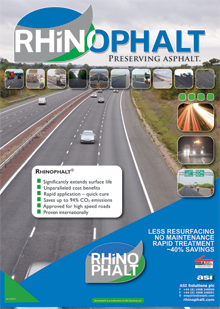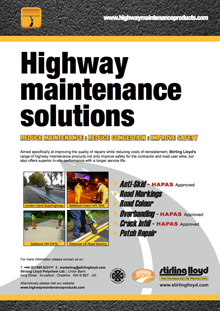eNews
Issue 9 | Spring 2013
Clients' view
The RSTA Annual Conference, ‘Appreciating Your Biggest Asset’, heard a range of clients call for a new mind-set of real investment, long-term planning and signing-up to best practice.
Nicola Walker, Head of Infrastructure and Environment at the CBI, explained why proper investment in the highway network is essential for the promotion of economic growth. The call for such investment is becoming a clamour following the recent downgrading of the UK’s triple AAA status. Investment in infrastructure creates jobs, reduces business costs and increases the attractiveness of UK to foreign investment. There are signs that the Government is beginning to understand this. However, infrastructure investment will be subject to the new normal: private rather than public investment. If private funding is to be forthcoming then the Government must champion and sell the potential of UK infrastructure investment. It must implement a range of initiatives that guarantee fiscal return, remove planning and red tape barriers and prioritise projects that will really deliver. This means that there be the vision to look beyond one budget year plans and a readiness to implement planned programmes of investment that range from a minimum of five to ten years. Only then will Britain get moving.
Chris Allen-Smith, Group Manager (Eastern Herts) and Head of Profession, Asset Management and Maintenance, echoed the call for greater long-term planning. Annual patch-and-mend maintenance policies are not the way forward for good asset management. What is required are planned programmes of at least five years. Only then will highway departments be able to undertake meaningful asset management and whole government accounting that includes real whole life cost cycle planning. The need for such a long-term approach is underlined by the fact that the historic value of £20 billion for the highways network is out-of-date. The real current value of the highway network is £400 billion. The road network is a local authority’s most important asset. It therefore needs proper levels of investment and forward planning. For this to happen there needs to be a fundamental change of approach which will then allow local authorities to make the case to Government for levels of funding necessary for the long-term maintenance of roads.
Matthew Lugg, HMEP Advocate – seconded to Department for Transport, also saw the need for a new mind-set with regards to road maintenance. Referencing the annual ALARM pothole survey of the Asphalt Industry Alliance, there is a need for all highway network stakeholders to get together and lobby Government for greater funding otherwise the survey is seen as being just a product of vested interest rather than the call for action that it really is. There is also a need for a mind-set change within local authorities. Whilst some have adopted the recommendations of the Highways Maintenance Efficiency Programme (HMEP) others have yet to do so. Similarly, whilst some forward thinking local authorities have embraced asset management others are proving reluctant to do so. HMEP and asset management represent new thinking, shared best practice, and the establishment of positive dialogue and exchange of ideas between client, contractor and sub-contractor. If the potential for a better maintained road network is to be realised then all highway stakeholders from national and local government to industry contractor and supplier must be ready and willing to sign-up to best practice.
Dougie Millar, Materials and QA Advisor, Standards Branch, Transport Scotland, underlined the benefits of applying best practice and dialogue between client and contractor by providing an update on TS 2010, a new surface course specification. The specification was developed following problems with the quality and performance of stone mastic asphalt. Transport Scotland worked closely with industry to amend the domestic specification. This included taking note of how Germany, which is on a similar latitude to Scotland, addressed the problem. The new approach is based upon German specifications and experience and sees the stone mastic asphalt (SMA) mixture containing a gap-graded aggregate mix, polymer modified bitumen and additives including fibres. The newly laid SMA is treated with grit to increase early-life skid resistance. The new specification is being introduced on a project-by-project basis. Where is it has been used the resulting improved performance is significant. Despite two of the worse winters on record there have been no pot holes on roads with TS 2010 specified SMA. Overall, the approach promises a wide range of benefits including superior durability, lower noise levels, high resistance to permanent deformation decreased life-time costs, reduced use of expensive imported aggregates and increased use of a wide range of sustainable, locally sourced aggregates. Transport Scotland and RSTA are working together to develop a new specification for surface dressing in Scotland. Such specifications are important as with them comes the workforce training, proper installation and the use of best practice that means that the treated road surface will last – that is how to get more for less.
back to contents »
Nicola Walker, Head of Infrastructure and Environment at the CBI, explained why proper investment in the highway network is essential for the promotion of economic growth. The call for such investment is becoming a clamour following the recent downgrading of the UK’s triple AAA status. Investment in infrastructure creates jobs, reduces business costs and increases the attractiveness of UK to foreign investment. There are signs that the Government is beginning to understand this. However, infrastructure investment will be subject to the new normal: private rather than public investment. If private funding is to be forthcoming then the Government must champion and sell the potential of UK infrastructure investment. It must implement a range of initiatives that guarantee fiscal return, remove planning and red tape barriers and prioritise projects that will really deliver. This means that there be the vision to look beyond one budget year plans and a readiness to implement planned programmes of investment that range from a minimum of five to ten years. Only then will Britain get moving.
Chris Allen-Smith, Group Manager (Eastern Herts) and Head of Profession, Asset Management and Maintenance, echoed the call for greater long-term planning. Annual patch-and-mend maintenance policies are not the way forward for good asset management. What is required are planned programmes of at least five years. Only then will highway departments be able to undertake meaningful asset management and whole government accounting that includes real whole life cost cycle planning. The need for such a long-term approach is underlined by the fact that the historic value of £20 billion for the highways network is out-of-date. The real current value of the highway network is £400 billion. The road network is a local authority’s most important asset. It therefore needs proper levels of investment and forward planning. For this to happen there needs to be a fundamental change of approach which will then allow local authorities to make the case to Government for levels of funding necessary for the long-term maintenance of roads.
Matthew Lugg, HMEP Advocate – seconded to Department for Transport, also saw the need for a new mind-set with regards to road maintenance. Referencing the annual ALARM pothole survey of the Asphalt Industry Alliance, there is a need for all highway network stakeholders to get together and lobby Government for greater funding otherwise the survey is seen as being just a product of vested interest rather than the call for action that it really is. There is also a need for a mind-set change within local authorities. Whilst some have adopted the recommendations of the Highways Maintenance Efficiency Programme (HMEP) others have yet to do so. Similarly, whilst some forward thinking local authorities have embraced asset management others are proving reluctant to do so. HMEP and asset management represent new thinking, shared best practice, and the establishment of positive dialogue and exchange of ideas between client, contractor and sub-contractor. If the potential for a better maintained road network is to be realised then all highway stakeholders from national and local government to industry contractor and supplier must be ready and willing to sign-up to best practice.
Dougie Millar, Materials and QA Advisor, Standards Branch, Transport Scotland, underlined the benefits of applying best practice and dialogue between client and contractor by providing an update on TS 2010, a new surface course specification. The specification was developed following problems with the quality and performance of stone mastic asphalt. Transport Scotland worked closely with industry to amend the domestic specification. This included taking note of how Germany, which is on a similar latitude to Scotland, addressed the problem. The new approach is based upon German specifications and experience and sees the stone mastic asphalt (SMA) mixture containing a gap-graded aggregate mix, polymer modified bitumen and additives including fibres. The newly laid SMA is treated with grit to increase early-life skid resistance. The new specification is being introduced on a project-by-project basis. Where is it has been used the resulting improved performance is significant. Despite two of the worse winters on record there have been no pot holes on roads with TS 2010 specified SMA. Overall, the approach promises a wide range of benefits including superior durability, lower noise levels, high resistance to permanent deformation decreased life-time costs, reduced use of expensive imported aggregates and increased use of a wide range of sustainable, locally sourced aggregates. Transport Scotland and RSTA are working together to develop a new specification for surface dressing in Scotland. Such specifications are important as with them comes the workforce training, proper installation and the use of best practice that means that the treated road surface will last – that is how to get more for less.
back to contents »
Copyright 2013 Road Surface Treatments Association. www.rsta-uk.org











